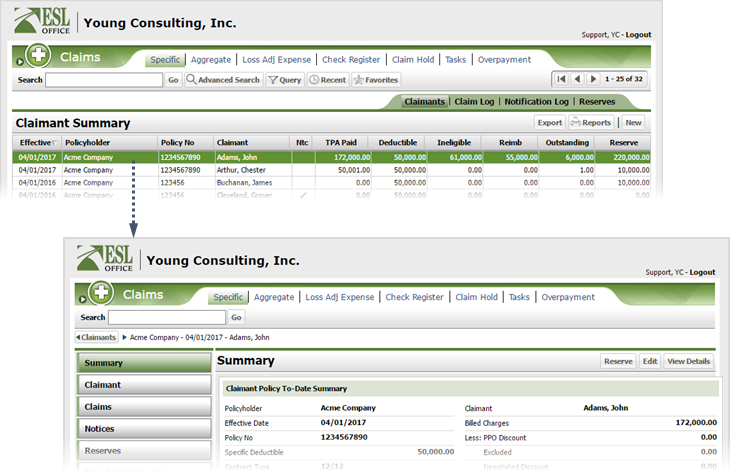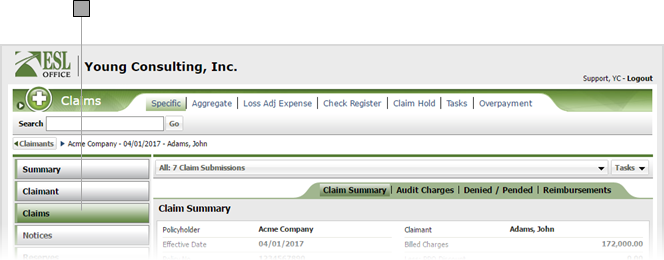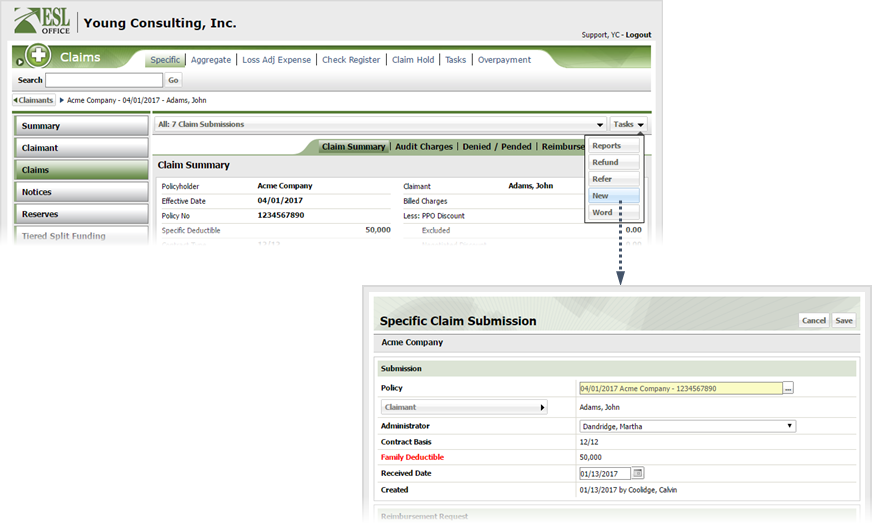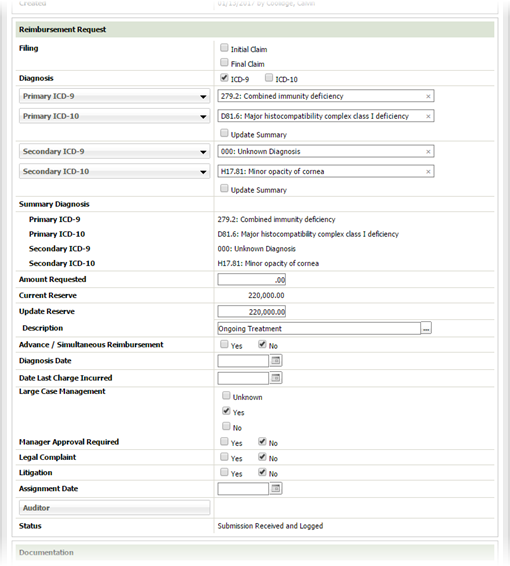2
Document a Submission for a Specific Claimant
2.1
Search the desired claimants from any specific sub tab.
2.2
Click the desired claimant from the list.

2.3
Click the Claims button.

2.4
Click Tasks then New to display the Specific Claim Submission window.

2.5
Document submission information as follows
Policy
Claim policy. Populated by ESL Office based on your claimant selection.
Claimant
Claimant making the claim. Populated by ESL Office and is the claimant you specified.
Administrator
Select who is administering the claim from the drop-down.
Contract Basis
Contract basis for the selected policy.
Deductible
Deductible for the policy. Will include Family if the claim is for someone other than the employee.
Received Date
When the new submission was received. Defaults to today's date. Enter a new date directly in the field in MM/DD/YYYY format or click the calendar icon and set the date using the date picker tool.
Created
Who created the initial claim and when. Populated by ESL Office.
2.6
Document the reimbursement request as follows.

Filing
Specify whether this is an initial or final claim by checking the appropriate box.
Diagnosis
Check the box corresponding to the ICD codes you will be using for diagnosis information.
Primary ICD-9
Click the button and search for and specify the primary ICD-9 diagnosis using the Select Claim Diagnosis window.
Primary ICD-10
Click the button and specify the primary ICD-10 diagnosis. If you are using ICD-9 diagnosis codes (the ICD-9 box is checked), clicking the Primary ICD-10 button displays the Select ICD-10 Diagnosis window where you can select the corresponding ICD-10 code. If you are using ICD-19 diagnosis codes (the ICD-10 box is checked), the Select Claim Diagnosis window appears where you can search for and select the appropriate ICD-10 diagnosis. If you want to update the summary with the diagnosis, check the Update Summary box.
Secondary ICD-9
Click the button and search for and specify the secondary ICD-9 diagnosis using the Select Claim Diagnosis window.
Secondary ICD-10
Click the button and specify the secondary ICD-10 diagnosis. If you are using ICD-9 diagnosis codes (the ICD-9 box is checked), clicking the Secondary ICD-10 button displays the Select ICD-10 Diagnosis window where you can select the corresponding ICD-10 code. If you are using ICD-10 diagnosis codes (the ICD-10 box is checked), the Select Claim Diagnosis window appears where you can search for and select the appropriate ICD-10 diagnosis. If you want to update the summary with the diagnosis, check the Update Summary box.
Summary Diagnosis
Displays the diagnosis you selected above when you check the Update Summary box.
Amount Requested
Enter the reimbursement request amount here.
Current Reserve
Current reserve. Populated by ESL Office based on your claimant selection.
Update Reserve
If desired, modify the reserve in this field.
Description
Provide a description for the reserve update here by clicking the button next to the field and specifying the reason from the Select Reason window.
Advance / Simultaneous Reimbursement
Specify whether the policy provides for advance or simultaneous reimbursement by checking the corresponding box.
Diagnosis Date
When the diagnosis was made. Enter the date directly in the field in MM/DD/YYYY format or click the calendar icon and set the date using the date picker tool.
Date Last Charge Incurred
When the last charge was incurred. Enter the date directly in the field in MM/DD/YYYY format or click the calendar icon and set the date using the date picker tool.
Large Case Management
Specify whether or not the claim falls under large case management by checking the corresponding box.
Manager Approval Required
Specify whether manager approval for the claim is required by checking the corresponding box.
Legal Complaint
Specify whether or not there is a legal complaint by checking the corresponding box.
Litigation
Specify whether or not there is litigation by checking the corresponding box.
Assignment Date
When the claim was assigned. Enter the date directly in the field in MM/DD/YYYY format or click the calendar icon and set the date using the date picker tool.
Auditor
Click the button and specify the auditor, if any, from the Auditor window.
Status
Claim status. Populated by ESL Office.
2.7
Enter any desired comments in the Comments text area. If you want to add any documentation to the submission, click the Attachment button and locate the desired document.

2.8
Click Save to create the submission.